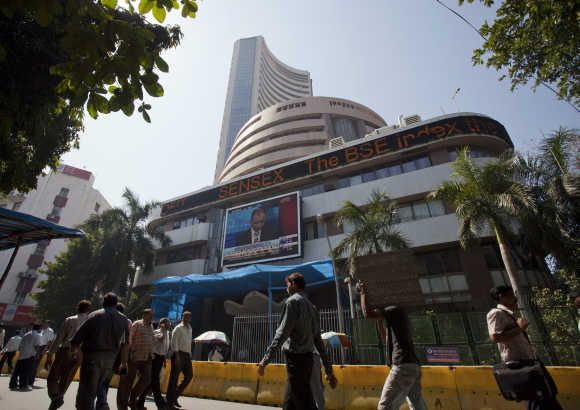The 2008 global financial crisis changed corporate India's earnings trajectory.
Demonetisation has the potential to inflict similar damage, reports Krishna Kant.

Demonetisation could push India Inc's earnings trajectory downwards in a repeat of the fallout of the 2008 global financial crisis, some experts said.
After the Lehman crisis, there was a sudden drop in the underlying earnings of the Sensex companies and the earnings trajectory never fully recovered when normalcy returned in the second half of 2009.
Corporate earnings are likely to drop sharply during the next two quarters with some effect spilling over to the next financial year, according to brokerage firms.
Ambit Capital has cut the Sensex underlying earnings per share (EPS) for 2016-2017 by 7% to Rs 1,396 from a previous estimate of Rs 1,496.
The firm has also cut the earnings estimates for 2017-2018 to Rs 1,530 per share from an earlier estimates of Rs 1,782. In comparison, the Sensex's current underlying EPS is Rs 1,281.
'In the light of our expectation of weak growth over the next two quarters, it is highly unlikely that 2016-2017 Sensex earnings per share would be able to reach the kind of levels being estimated by our analysts currently. We now build in a flat earnings growth for the Sensex during 2016-2017 over the previous year,' said Ambit Capital in its recent report on demonetisation.
Dhananjay Sinha, head, institutional equity, Emkay Global Financial Services, expects a double blow to corporate earnings in the next two quarters.
"Corporate earnings will be affected by a combination of demonetisation and steadily rising commodity prices. While the former will bring down revenue growth, the latter will result in higher operating costs and lower operating margins. The end result could be flat profit growth during the next two quarters," he said.
The combined net profit of around 2,500 companies that have declared their July-September results was up 3.5%, year on year, while net sales was up 1.3%.
The demand destruction unleashed by demonetisation and the resulting cash crunch could result in a fall in revenue during the third quarter.
This would be a repeat of what had happened to corporate India in the aftermath of the 2008 global financial crisis.
A freeze on credit flow after the crisis led to a sudden drop in demand (net sales) and profit.
The underlying earnings per share of Sensex companies had fallen of the cliff beginning July 2008 and finally bottomed out in March 2009.
In all, the index EPS was down 15% during the period.
Sensex earnings per share would have been higher by around 75% if they had maintained their pre-crisis trajectory.
The pain for corporate India could last longer if the demand slowdown and poor profitability result in more bad loans for banks.
"Any further rise in banks’ non-performing assets will have a ripple effect throughout the economy by way of lower credit growth and the fiscal cost of bank re-capitalisation," Sinha said.
Others, however, said it would be business as usual once liquidity in the system normalised.
"Corporate earnings and economic growth are likely to normalise in 2017-2018. There will be some lingering pain for the real estate sector and related industries, but their overall weight is not big enough to derail India's growth story," said G Chokkalingam, founder and CEO, Equinomics Research & Advisory.
Demonetisation: FY17 credit growth could slip to 6%: Jefferies
Nupur Anand reports from Mumbai.
Credit growth which has been languishing in single digits for several quarters may slip even further to 6% in this financial year as a result of demonetisation, say Jefferies.
The research firm has halved the credit growth outlook for this financial year to 6% from 12%.
"Beyond the cash-freeze worries, discretionary consumption takes a hit, exacerbated by a squeeze as untaxed currency moves out of the system or its velocity slows down and demand/sentiment adjusts to the new reality," said Nilanjan Karfa and Avinash Singh of Jefferies.
"This could take anywhere between two to six quarters, if not longer. Private investments have been weak and unlikely to improve under these conditions," they added.
As a result of this factor the analysts have cut system loan growth to 6% (FY17), 9% (FY18) and 15% (FY19) as compared to 12%, 15% and 15%respectively.
As per the Reserve Bank of India data, credit offtake had touched a record low of 7.2% in June 1994.
This comes at a time when current and savings account deposits have swelled up in the wake of demonetisation and expectations of lending rate cuts have become stronger.
In fact in his recent speech, Prime Minister Narendra Modi announced that there will be cheaper loans soon. However, if analysts are to be believed there may not be enough takers for these cheaper loans.
Bank credit offtake had been sluggish and had remained in single digits as corporate credit growth has been slow.
Even though, banks -- especially the private sector lenders -- have seen a robust growth in retail credit it is the dismal growth in corporate lending that has pulled down overall credit growth.
The corporate credit has been mainly limited to working capital and loan for new investments have been limited.











